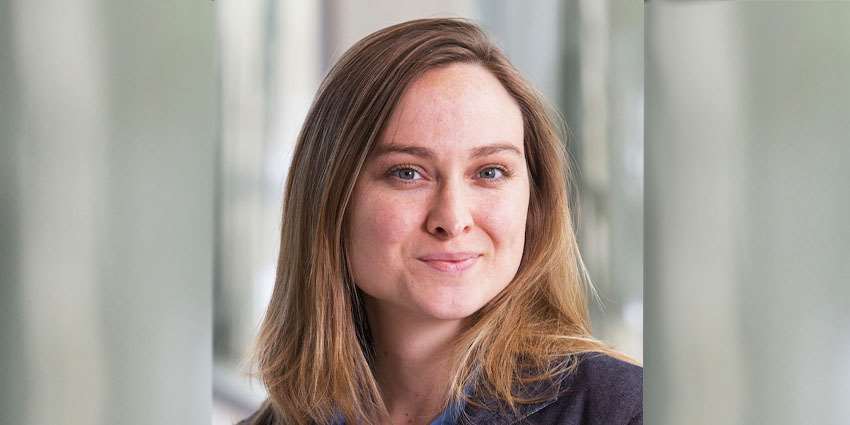Article originally written by Ava English
Lindsay Sansom, Ph.D., fell in love with water growing up in the Texas Hill Country and has spent her entire career helping others connect with their local water sources.
Every summer during Sansom’s childhood she would swim in Jacob’s Well, a deep artesian spring that is fed by groundwater, and fish in the Blanco River. However, near high summer she would notice those swimming holes would diminish or disappear depending on the severity of the drought that year.
“Growing up with such a strong connection to my local waterways, I always knew I wanted a career working towards protecting water,” said Sansom.
Her first dip into this career path was her first job out of college working with AmeriCorps in East Austin. Here, she did outreach projects and taught environmental science to school-aged kids.
One event Sansom organized while working at AmeriCorps was a street clean-up for the local waterway. “For many of these kids, they had never visited their creek, and for me, I had never been to a creek that was so polluted,” she said.
She realized the extent to which some people are disconnected from their water sources. “It not only solidified the importance of protecting our waterways but also showed me just how vital it is to connect communities to their own surroundings,” she said.
She then decided to continue her education and research new ways to boost increase community engagement and expand water conservation. “I have always been passionate about water and research is one avenue to ensure the protection of this resource.”
She pursued dual master’s degrees in international relations and environmental policy from Boston University. For her master’s thesis, she was required to focus on something related to international relations, but she felt a strong pull to return to her home state. “That’s why I focused my research on transboundary groundwater sharing between Ciudad Juarez, Mexico, and El Paso, Texas over the Hueco Bolson aquifer,” she said.
After graduating from Boston University and returning to Texas, she expanded the research she conducted for her master’s degrees to her doctoral studies at Texas A&M University in the Department of Ecosystem Science and Management. There, she examined how perceptions of risk and levels of trust influences decision-making along the Texas-Mexico border.
“It didn’t take long for me to realize how much I love research, but it wasn’t necessarily a planned career choice,” she said. Sansom continues to work on transboundary water sharing issues and has expanded her research endeavors to include water quality issues, particularly in minority-majority neighborhoods.
Each of her educational and professional experiences affirmed her desire to connect with people to protect water. The most illuminating of these experiences was the first time she was involved in facilitating a stakeholder engagement meeting for a watershed protection plan for the San Marcos River. “It was the first time that I had done something so applied,” Sansom said.
This experience also increased her understanding of the complexities of environmental issues. “Gathering community members with different concerns and values into the same room to discuss the current and future condition of the river was powerful because suddenly potential water and land management policies had real implications for real people,” she said. “It made everything go from fairly black and white to many shades of grey.”
Learning from diverse voices and working on interdisciplinary teams energizes Sansom and she applies it to every aspect of her career. “I love working with communities to find real-world solutions or compromises to complicated environmental issues,” she said. “In fact, this is one of the things that I try to incorporate into my class as well: the idea of understanding diverse stakeholder values.”
Sansom is a research assistant professor in the Geography Department in the College of Geosciences and teaches a course on environmental change at Texas A&M University.
She recently launched a student-run podcast titled, “Our Earth Rising” that gives students the opportunity to learn and communicate environmental topics from multiple viewpoints. While researching a topic for the podcast, Sansom encourages her students to discuss the topics with experts across many disciplines at Texas A&M University to understand the diverse perspectives and nuances of environmental issues.
Sansom enjoys the challenges of introducing her students to environmental topics and teaching them to think critically about them. “Each semester, I have between 200-400 undergraduates and for many of them, it is the only science course they will take at a university level, so I try to make environmental change topics relevant and relatable for students from all walks of life,” she said.
Although she loves teaching, Sansom hopes in the future she will have more opportunities to do fieldwork. “I want to not only be out in nature but also to work directly with community members to foster a love for their natural heritage,” she said.
It’s not surprising that Sansom is aiming to spend more time outdoors, given that her favorite pastimes include hiking, camping, canoeing — or pretty much anything that gets her outside. However, above all, she said, “swimming in the summertime will always be a lifelong favorite.”



